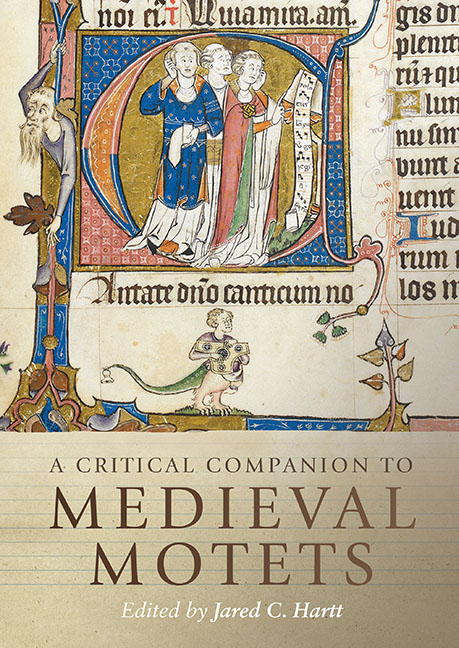Book contents
- Frontmatter
- Dedication
- Contents
- List of Figures
- List of Music Examples
- List of Tables
- List of Contributors
- Preface
- Acknowledgments
- Abbreviations
- Introduction: Approaching Medieval Motets
- 1 The Genre(s) of Medieval Motets
- 2 Origins and Interactions: Clausula, Motet, Conductus
- 3 Tracing the Tenor in Medieval Motets
- 4 Isorhythm
- 5 Notation
- 6 Thirteenth-Century Motet Functions: Views through the Lens of the Portare Motet Family
- 7 A Prism of its Time: Social Functions of the Motet in Fourteenth-Century France
- 8 Motets, Manuscript Culture, Mise-en-page
- 9 Clerics, Courtiers, and the Vernacular Two-Voice Motet: The Case of Fines amouretes / Fiat and the Roman de la poire
- 10 When Words Converge and Meanings Diverge: Counterexamples to Polytextuality in the Thirteenth-Century Mote
- 11 Motets in Chansonniers and the Other Culture of the French Thirteenth-Century Motet
- 12 Building a Motet around Quoted Material: Textual and Musical Structure in Motets Based on Monophonic Songs
- 13 The Duet Motet in England: Genre, Tonal Coherence, Reconstruction
- 14 Materia Matters: Reconstructing Colla/Bona
- 15 Machaut’s Motet 10 and its Interconnections
- 16 A Motet Conceived in Troubled Times: Machaut’s Motet 22
- 17 A Motet Ahead of its Time? The Curious Case of Portio nature/Ida capillorum
- Bibliography of Works Cited
- Select Glossary
- Index of Cited Motets
- General Index
- Studies in Medieval and Renaissance Music
1 - The Genre(s) of Medieval Motets
Published online by Cambridge University Press: 21 October 2020
- Frontmatter
- Dedication
- Contents
- List of Figures
- List of Music Examples
- List of Tables
- List of Contributors
- Preface
- Acknowledgments
- Abbreviations
- Introduction: Approaching Medieval Motets
- 1 The Genre(s) of Medieval Motets
- 2 Origins and Interactions: Clausula, Motet, Conductus
- 3 Tracing the Tenor in Medieval Motets
- 4 Isorhythm
- 5 Notation
- 6 Thirteenth-Century Motet Functions: Views through the Lens of the Portare Motet Family
- 7 A Prism of its Time: Social Functions of the Motet in Fourteenth-Century France
- 8 Motets, Manuscript Culture, Mise-en-page
- 9 Clerics, Courtiers, and the Vernacular Two-Voice Motet: The Case of Fines amouretes / Fiat and the Roman de la poire
- 10 When Words Converge and Meanings Diverge: Counterexamples to Polytextuality in the Thirteenth-Century Mote
- 11 Motets in Chansonniers and the Other Culture of the French Thirteenth-Century Motet
- 12 Building a Motet around Quoted Material: Textual and Musical Structure in Motets Based on Monophonic Songs
- 13 The Duet Motet in England: Genre, Tonal Coherence, Reconstruction
- 14 Materia Matters: Reconstructing Colla/Bona
- 15 Machaut’s Motet 10 and its Interconnections
- 16 A Motet Conceived in Troubled Times: Machaut’s Motet 22
- 17 A Motet Ahead of its Time? The Curious Case of Portio nature/Ida capillorum
- Bibliography of Works Cited
- Select Glossary
- Index of Cited Motets
- General Index
- Studies in Medieval and Renaissance Music
Summary
MARK EVERIST began the final chapter of his 1994 monograph with the statement that ‘The motet is a genre’. Certainly, musicologists broadly seem able to agree that certain musical pieces are medieval motets when they encounter them. Nonetheless, the questions of whether the medieval motet is a genre, and if so, how this genre arose and what characteristics define it, have become more difficult to answer in recent years, not least on account of the ongoing work of Everist and those who have studied with him. As many of the contributions to this volume attest, there is significant flexibility and generic porousness between clausulae and motets, conductus and motets, and songs and motets. This chapter suggests that this might be because those things termed motets today are themselves a hybridization of other genres whose transmission history – comprising items largely collected retrospectively after significant use, adaptation, and further hybridization – makes it difficult, perhaps impossible, to uncover the multiple pathways through which this universe of medieval motets came about. Observing the shapes of galaxies in still images allowed astronomers to develop a taxonomy and then to model galaxy formation using physical laws, deriving a dynamic history for each object based on present observations. The frozen snapshot offered by surviving manuscripts might seem analogous to these telescope images, but musicologists have no such firm laws from which to track back, so are forced to make more speculative arguments from close readings, musical and notational analysis, and assumptions about chronology. This chapter will look again at issues of genre, origins, and evolution using the evidence of the large motet collection in D308. Lacking notation, this collection has been generally disregarded, yet it provides the sole meeting point for two kinds of motets that never otherwise appear together: examples of the so-called motet enté, a monophonic subgenre only otherwise found in fr.845, and the motetus texts of a number of widely transmitted ‘mainstream’ polyphonic motets.
To read most textbooks or dictionaries of music is to be told that the motet as a genre arose through the trope-like and mainly syllabic Latin texting of the upper voice(s) of a discant clausula, a polyphonic and rhythmically patterned elaboration of a melismatic section of liturgical chant.
- Type
- Chapter
- Information
- A Critical Companion to Medieval Motets , pp. 15 - 42Publisher: Boydell & BrewerPrint publication year: 2018

